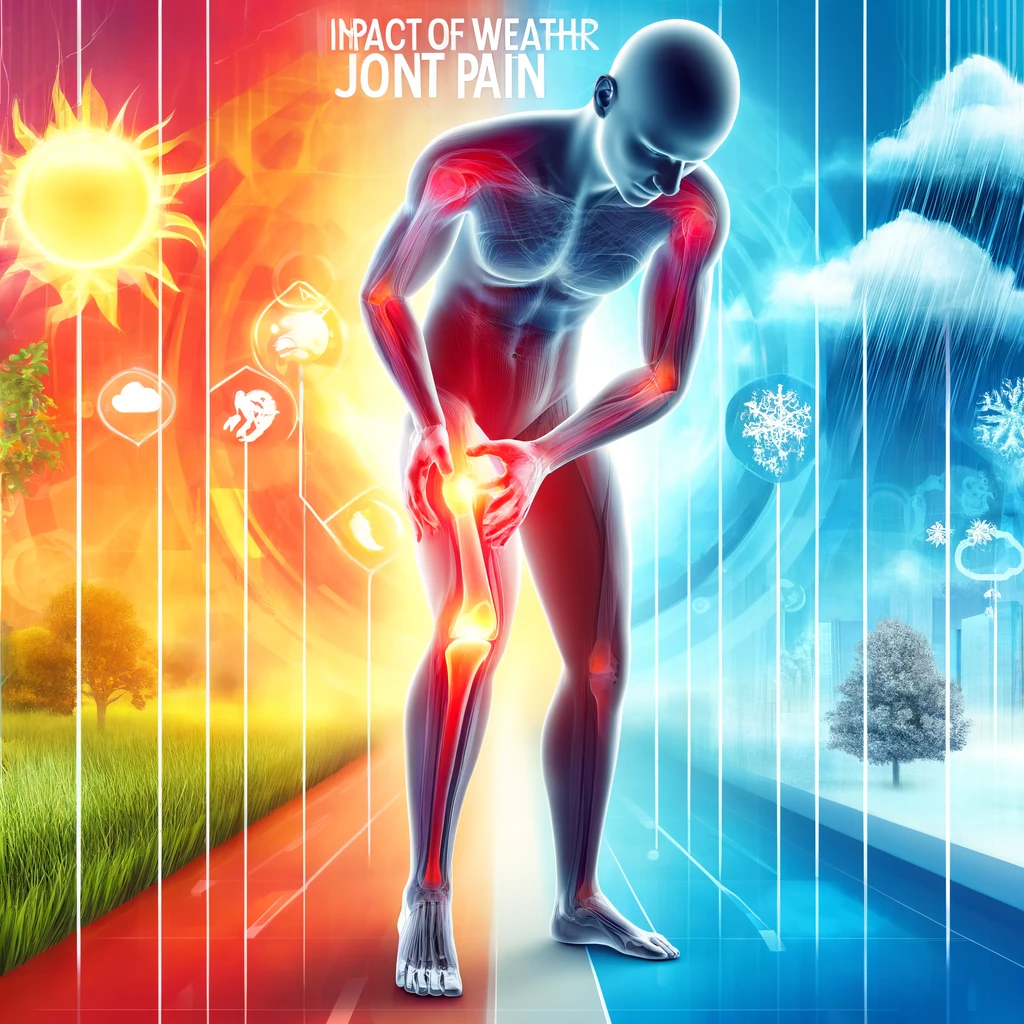
Joint pain is a common ailment affecting millions worldwide. It can significantly impact one’s quality of life, making it essential to understand the factors that can exacerbate or alleviate this pain. One such factor is the weather. The impact of weather on joint pain is a topic of much discussion and interest. In this article, we’ll delve into how different weather conditions affect joint pain and what you can do to manage it effectively.
Importance of Understanding Weather’s Impact
Understanding how weather affects joint pain can help you take proactive steps to manage your symptoms, improving your overall well-being and quality of life.
How Weather Affects Joint Pain
Temperature Changes
Have you ever noticed your joints aching more when it’s cold outside? You’re not alone. Many people report increased joint pain during colder months. The cold weather can cause muscles to stiffen and joints to become less flexible, leading to discomfort and pain.
Barometric Pressure
Barometric pressure, the weight of the air surrounding us, changes with the weather. When the barometric pressure drops, which often happens before a storm, it can cause joints to swell, leading to increased pain.
Humidity Levels
High humidity can also impact joint pain. It can lead to increased swelling and discomfort in the joints, particularly in those who suffer from arthritis.
Seasonal Variations
Different seasons bring different challenges for those with joint pain. Winter’s cold can increase pain and stiffness, while summer’s heat can sometimes cause swelling. Understanding these patterns can help you better manage your symptoms.
Scientific Explanations
Barometric Pressure and Joint Pain
Scientific studies suggest that changes in barometric pressure can influence joint pain. Lower pressure allows tissues to expand, which can put pressure on the joints and cause pain. This is why many people feel their joints ache just before it rains.
Temperature and Blood Circulation
Cold weather can reduce blood flow to extremities, leading to increased pain and stiffness in the joints. On the other hand, warmer weather can improve circulation and sometimes reduce pain.
Humidity and Joint Swelling
High humidity levels can lead to increased fluid retention, causing joints to swell and become more painful. This is particularly noticeable in those with arthritis.
Personal Experiences and Anecdotes
Common Reports from Arthritis Patients
Many arthritis patients report that their symptoms worsen with changes in weather. Cold, damp days are often cited as particularly troublesome.
Personal Stories
Jane, a 54-year-old woman with rheumatoid arthritis, shared that her joints always ache more before a storm. “It’s like my body is a weather predictor,” she said. Stories like Jane’s are common among those with joint pain.
Types of Joint Pain Affected by Weather
Arthritis
Arthritis is one of the most common types of joint pain affected by weather. Both osteoarthritis and rheumatoid arthritis patients report increased pain with weather changes.
Osteoarthritis
Those with osteoarthritis often find that cold, damp weather exacerbates their symptoms, causing increased pain and stiffness.
Rheumatoid Arthritis
Rheumatoid arthritis sufferers may experience increased pain and swelling during periods of high humidity or rapid weather changes.
Symptoms Worsened by Weather
Increased Pain Levels
Weather changes can lead to more intense pain levels, making daily activities more challenging.
Stiffness
Cold weather can cause joints to stiffen, reducing mobility and flexibility.
Swelling
High humidity and low barometric pressure can lead to joint swelling, increasing discomfort.
Weather Patterns and Joint Pain
Cold Weather
Cold weather often leads to increased joint pain and stiffness. It is essential to keep joints warm and mobile during these times.
Warm Weather
While warm weather can sometimes reduce joint pain, extreme heat can lead to swelling and discomfort.
Rainy Weather
Many people with joint pain report that their symptoms worsen just before or during rainy weather, likely due to drops in barometric pressure.
Tips for Managing Joint Pain in Different Weathers
Cold Weather Management
- Stay Warm: Dress in layers and keep your home heated.
- Stay Active: Gentle exercises can keep joints flexible.
- Hydrate: Drink plenty of water to keep joints lubricated.
Warm Weather Management
- Stay Cool: Avoid excessive heat and stay in air-conditioned environments.
- Exercise: Opt for water exercises to reduce stress on joints.
- Hydrate: Increased fluid intake is crucial.
Humid Weather Management
- Dehumidify: Use a dehumidifier to reduce moisture levels in your home.
- Stay Dry: Wear moisture-wicking clothing.
- Hydrate: Maintain fluid balance to prevent swelling.
Home Remedies and Lifestyle Changes
Exercise and Physical Activity
Regular exercise can help maintain joint function and reduce pain. Low-impact activities like swimming and cycling are particularly beneficial.
Diet and Nutrition
Eating a balanced diet rich in anti-inflammatory foods can help reduce joint pain. Omega-3 fatty acids, found in fish and antioxidants, found in fruits and vegetables, are particularly helpful.
Stress Management
Stress can worsen joint pain, so finding ways to relax and manage stress is essential. Practices like yoga, meditation and deep breathing can help.
Medical Treatments and Therapies
Medications
Over-the-counter pain relievers and prescription medications can help manage joint pain. Always consult with a healthcare provider before starting any new medication.
Physical Therapy
Physical therapy can help improve joint function and reduce pain. A physical therapist can provide exercises tailored to your specific needs.
Alternative Treatments
Acupuncture, massage, and chiropractic care are alternative treatments that some people find helpful for managing joint pain.
Prevention Strategies
Staying Active
Regular physical activity is crucial for maintaining joint health. Even gentle movements can make a big difference.
Proper Clothing
Wearing appropriate clothing for the weather can help manage joint pain. Keep warm in the winter and cool in the summer.
Hydration
Staying hydrated is essential for joint health. Water helps keep joints lubricated and functioning properly.
When to See a Doctor
Identifying Severe Symptoms
If your joint pain is severe, persistent, or accompanied by other symptoms like fever or weight loss, it’s essential to see a doctor.
Professional Diagnosis and Treatment
A healthcare provider can diagnose the cause of your joint pain and recommend appropriate treatments, which may include medications, physical therapy, or other interventions.
Conclusion
Understanding the impact of weather on joint pain can help you manage your symptoms more effectively. By paying attention to how your joints respond to different weather conditions and taking proactive steps, you can reduce your discomfort and improve your quality of life.
FAQs
How does cold weather affect joint pain?
Cold weather can cause muscles to stiffen and joints to become less flexible, leading to increased pain.
Can warm weather reduce joint pain?
Warm weather can sometimes reduce pain by improving blood circulation, but extreme heat may cause swelling and discomfort.
What is the role of barometric pressure in joint pain?
Changes in barometric pressure can cause tissues to expand and put pressure on joints, leading to increased pain.



